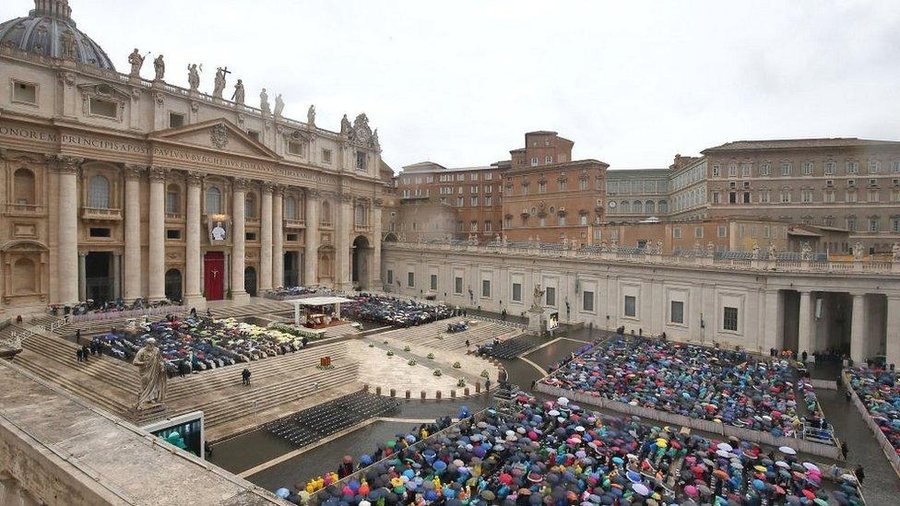What happens after the Pope dies? - Steps to electing a new successor at the head of the Catholic Church

With the death of Pope Francis, the Catholic Church will begin the elaborate traditional rituals that mark the end of one papacy and the beginning of another.
Most of them are governed by a constitution known as Universi Dominici Gregis, approved by Pope John Paul II in 1996 and revised by Pope Benedict XVI in 2007 and 2013.
A cardinal known as a chamberlain, currently Irish-American Kevin Farrell, will lead the ordinary affairs of the Roman Catholic Church of nearly 1.4 billion members during the period known as the "sede vacante" (empty chair).
He officially confirms the Pope's death, a simple matter these days, involving a doctor and a death certificate. Until the 20th century, this was done by tapping the Pope's forehead with a silver hammer three times. The camerlegno and three assistants ensure that the Pope's "Fisherman's Ring" and his seal are broken, so that they cannot be used by anyone else. No autopsy is performed on his body.
The heads of most Vatican departments resign until the new pope confirms or replaces them.
Mourning rites last nine days, with the date of the funeral and burial to be decided by the cardinals. Pope Francis, who has shunned many of the privileges of leading the global Catholic Church, modified and simplified the papal burial rites in 2024.
The funeral mass is still expected to be held in St. Peter's Square, but unlike many predecessors, Francis asked to be buried in Rome's Basilica of St. Mary Major to be near his favorite icon.
Francis also asked to be buried in a simple wooden coffin, unlike his predecessors who were buried in three intertwined coffins of cypress, lead and oak. He requested that his body not be displayed on a raised platform, or catafalque, in St. Peter's Basilica for visitors to Rome to see, as had been the case with previous popes.
conclave
Cardinals from around the world gather in Rome after the death of a pope. They hold daily meetings known as general congregations to discuss Church matters and to outline the characteristics each believes the new pope should have. Cardinals aged 80 and over may participate in general conclaves, but are not allowed to enter the conclave to elect the next pope.
Traditionally, a 15-day mourning period is observed before a conclave begins. Before he resigned in 2013, Pope Benedict modified the constitution to allow it to begin sooner if the cardinals wanted, or a maximum of 20 days after the death if some of them faced difficulties getting to Rome.
The conclave is held in the Sistine Chapel. The word “conclave” comes from the Latin, meaning “with a key.” It stems from a tradition that began in the 13th century, where cardinals were locked inside, a way to encourage them to decide quickly and limit outside interference.
During these days, participants are prohibited from any communication with the outside world. Telephones, the internet and newspapers are not allowed, and Vatican police use electronic devices to ensure compliance with the rules.
For election, a two-thirds plus one majority is required. If no one is elected after 13 days, a runoff is held between the two leading candidates, but a two-thirds plus one majority is still required. This is intended to promote unity and discourage the election of compromise candidates.
When the conclave elects the Pope, he is asked if he accepts and what name he wants to take. If he refuses, the procedure starts over.

China restricts mineral exports - Critical metal controls "hit" international supply
China's export controls on three metals crucial to the defense and chip sectors are keeping shipments at historically low levels despite high prices......

Pope Francis passes away - A voice for the poor who reshaped the Catholic Church
Pope Francis, a voice for the poor who reshaped the Catholic Church but faced fierce resistance, has died at the age of 88, the Vatican said. The Pope's......

Albanian medicinal plants increase presence in the US - American companies buy 177 tons of "Made in Albania" products
Although the 10% tariff imposed by US President Donald Trump on goods imported from Albania has not yet come into effect, where a sector that is greatly......

"The role of women in society is growing" - Albania 2030, Rama: We have more female entrepreneurs
The country's Prime Minister, Edi Rama, in a meeting with women in the city of Kavaja emphasized that the role of women in society continues to be......

Land without title deeds goes on sale for 1 euro - The "Mountain Package" comes into effect in May, the criteria for who benefits
The "Mountain Package", which aims to attract investments in priority development areas, strengthen local economies, and promote employment, has been......

Shkodra, 793 new POS terminals in 2024 - In which regions are electronic payments being promoted the most? BoS: Tirana, the smallest growth
Businesses in Shkodra and Lushnja are the ones that have installed the most POS terminals in 2024. Although Tirana has the largest number of these terminals,......

New power plants produced 1.81% of energy - ERE: 26 plants were added to production capacities, 18 of them are solar
1.81% of electricity was produced by plants that entered production during 2024. According to data from the Energy Regulatory Authority, last year the net......

Can Canada join the EU? - Tensions with Trump "incite" citizens to seek union
As U.S. President Donald Trump is upending relations with his northern neighbor through punitive tariffs and aggressive social media posts, Canadians are......





















